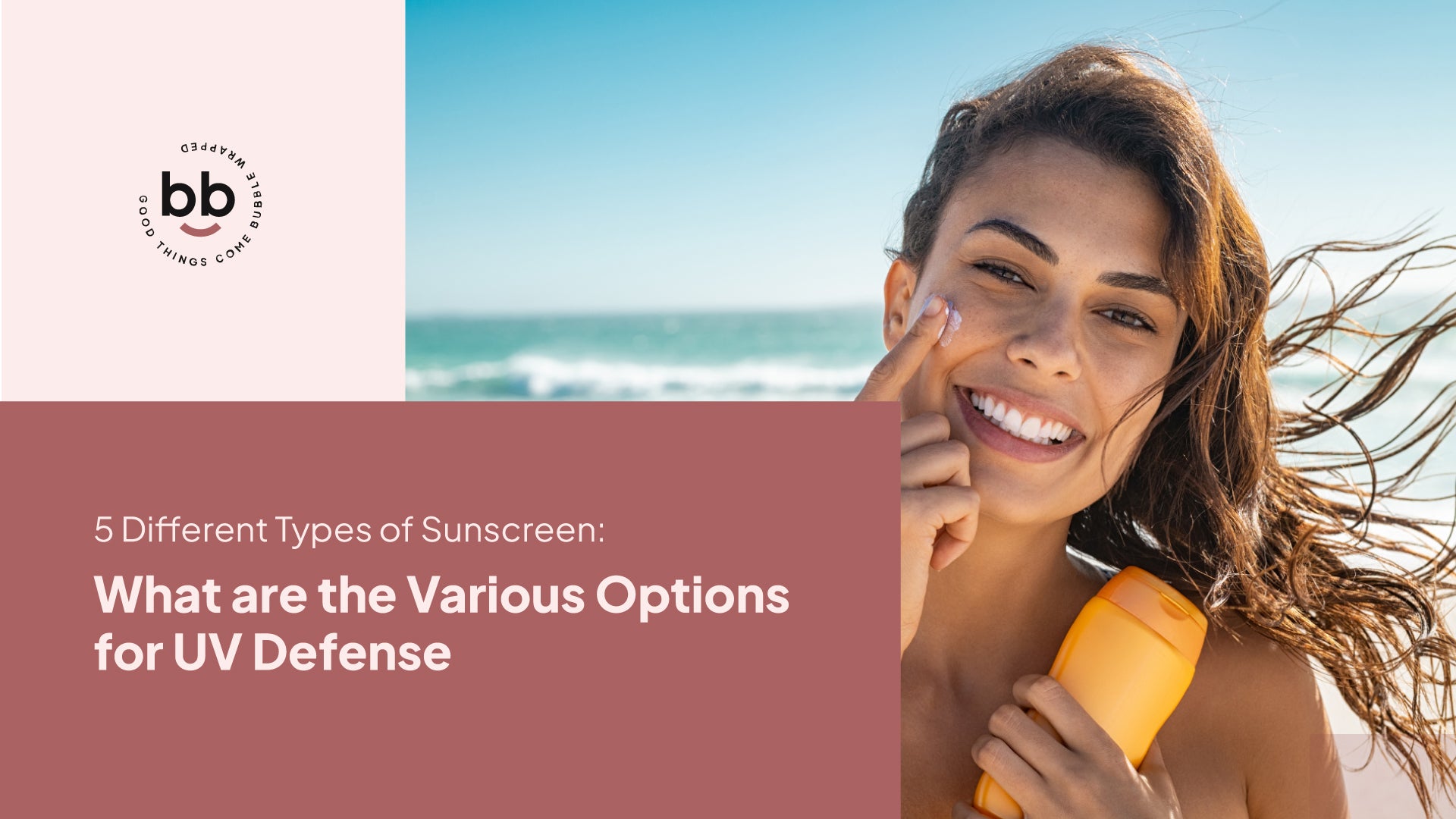5 Different Types of Sunscreen: What are the Various Options for UV Defense

Sunscreen stands as an essential guardian in the battle against the sun's potentially harmful ultraviolet (UV) rays. Its significance goes beyond mere cosmetic application; it is a pivotal component in safeguarding our skin's health and maintaining its youthful vitality. There are different types of sunscreen depending on their range of protection.
UV rays, primarily classified into UVA and UVB, pose considerable risks, including premature aging, sunburn, and heightened skin cancer susceptibility. Comprehending the pivotal role of sunscreen in UV protection is paramount.
UVA rays penetrate deeply into the skin, leading to premature aging, pigmentation irregularities, and the breakdown of collagen fibers. UVB rays are responsible for the notorious sunburns that afflict individuals after prolonged sun exposure.
Both types of UV radiation have a link to skin cancer development over time. You need to use different types of sunscreen that act as a barrier, offering a shield against these harmful rays. It acts as a filter that absorbs, scatters, and reflects UV radiation, thwarting its ability to penetrate the skin.
A common misconception is that sunscreens are exclusively crucial during peak summer months or at the beach. However, UV rays are present year-round. Incorporating different types of sunscreen, based on your skin and protection needs, into daily routines remains vital. From chemical to physical sunscreens, tinted variations to those specially formulated for the face, choose one for your needs.
In this blog, you will find how sunscreen and its varieties stand as an everyday armor, defending our skin from UV onslaught and helping us cherish healthy skin for years to come.

5 Different Types of Sunscreen For Maximum SPF Protection
Dive into the realm of sunscreen variety. Explore an array of sunscreen types designed to cater to diverse preferences and skin needs. From chemical formulations to mineral barriers, tinted options to specialized face blends—discover different types of sunscreen from The Bubble Wrap.
1. Chemical Sunscreens (Organic Sunscreen)
Chemical sunscreens use multiple ingredients that your skin absorbs when you apply it. These chemicals absorb UV rays and turn them into energy so they do not harm your skin.
What sets it apart from different types of sunscreen is that they are not as thick. Their texture makes them perfect for your face. Since your skin must completely absorb this product, apply it at least 20 to 30 minutes before heading outdoors.
Its lotion-like texture easily absorbs into your skin, therefore, not forming a barrier on your skin. Its formula has active ingredients that convert UV light into heat so your skin remains unharmed. Go for products like COSRX Vitamin E Sunscreen and Beauty of Joseon Relief Sun.
Organic sunscreens when exposed to UV causes chemicals to evaporate more quickly. Therefore, you need to reapply it every few hours. This is, however, more needed if you are spending hours outdoors.
Unfortunately, it is not for people with sensitive and rosacea-prone skin and hyperpigmentation. Chemical sunscreens also release heat.
These different types of sunscreen contain avobenzone, octinoxate, oxybenzone, octocrylene or a combination of all. It is problematic as heated skin can cause an increase in existing brown spots. They can also clog pores causing problems for acne-prone skin.
1.1. Organic Sunscreen
The term “organic” can be a little misleading. Since chemical sunscreens use broad spectrum filters for UVA and UVB rays with “organic substances” like carbon, consider them as “organic” amongst different types of sunscreen.
The term “organic” is usually misinterpreted. A product containing around 75% to 80% of organic substances can label itself as “organic”. So, which one can you choose?
As you look through different types of sunscreen, give priority to two factors:
- Broad-spectrum UV coverage
- If it is comfortable for daily use
- How much product do you need for coverage?
While you do need less product to cover your skin, it still allows some UVA exposure. They take time to show visible results. Avoid them if you have acne, rosacea, and hyperpigmentation as it exacerbates such skin issues.
Another one amongst the different types of sunscreen is mineral or physical ones. They sit on top of your skin and provide UV protection. If you are looking for broad-spectrum UV protection, know why mineral sunscreens are your best option.
2. Physical (Mineral) Sunscreens
Mineral sunscreens, also known as physical sunscreens, create a protective barrier on your skin to block the sun's rays. They reflect UV radiation away, providing broad-spectrum protection. These different types of sunscreen defend against UVA damage, such as wrinkles and hyperpigmentation.
They're effective even against UVA rays from windows, which cause pigmentation and collagen breakdown. That's why daily sunscreen use matters, indoors or outdoors.
Mainly containing zinc oxide and titanium oxide, mineral sunscreens offer broad-spectrum defense against UVA and UVB rays. They're ideal for daily use on the face and neck, guarding against year-round UVA damage. However, applying them generously is key. Avoid spray and powder versions to minimize inhaling nanoparticles.
While mineral sunscreens might seem chalky, tough to spread, and leave a noticeable white layer, particularly on darker skin tones.
3. Water-Resistant Formulas
One common annoyance that all of us face is after applying sunscreen when it comes off due to perspiration. Or about it wearing off after you take a dip in a pool or the ocean? So, there is no doubt that waterproof sunscreen is in high demand. It provides consistent sunblock even when you are perspiring.
Though it sounds too good to be true, waterproof sunscreen retains its sunblocking power even when you are in water. Just make sure to reapply it a few times. While brands use a variety of ingredients for such sunscreens, the three natural ingredients that you will find in all are:
- Beeswax
- Plant oils
- Alcohol
Such ingredients are what makes the sunscreen “waterproof”. It can protect your skin from sun rays for up to 40-80 minutes. Look for oil-free formulas and non-comedogenic ones that do not clog your pores.
If you like lightweight formulas, go for gel-based or light sunscreens. You can also look into tinted sunscreens as they not only provide Sun protection but also enhance your skin’s natural tone. Let’s find out more about it.

4. Tinted and Colored Sunscreens
Enjoying summer should not come at the cost of sunburns or sunscreens that leave a white cast. While you can use sunscreen underneath makeup, piling up products on your skin in summer will clog your pores. So, what is the solution?
Here is where different types of sunscreen like tinted formulas come in. Fairly a recent hype in skincare, tinted sunscreen is exactly like your regular sunscreen but it gives your skin a natural makeup-like finish.
There are sunscreens that range from light coverage to full coverage. There is no fear of white cast with a tinted formula. It can easily double up as a primer for your makeup. Tinted sunscreens can blend in with most types of skin tones and thus it makes a product more universal.
As you try to choose amongst different types of sunscreen, try a tinted option like Missha All Around Safe Block Soft Finish Sun Milk. Its formula does not interfere with your makeup while shielding your skin.
While all these sunscreen types cater to a variety of individuals based on coverage, SPF protection range or skin issues, there is another type that you can opt for. Choosing a sunscreen with “special” formula that caters to specific requirements of your skin takes you one step closer to optimum skincare.
5. Specialized Formulas for Face and Body
With so much talk about importance of sunscreen, you might have wondered, “Can I use the same sunscreen for my face and body?” The straightforward answer?- No. Your face’s skin is much thinner than your body’s. So, your face needs more protection and a tougher sunscreen than your body.
Sunscreens that are for body come in lotion or cream formulation, for instance, COSRX Vitamin E Vitalizing Sunscreen and MIssha All Around Safe Block. Usually body sunscreens have thicker ingredients.
Therefore, it makes them not suitable for all face skin types. For instance, oily or combination skin must avoid using thicker formula on their face as it can clog their pores.
To avoid a greasy feeling and still get full UV protection, use lightweight gel formulas. There are different types of sunscreen that have special formulations just for your face.
For instance, Beauty of Joseon Mugwort+ Camilla Matte Sun Stick has a non-greasy formula that deeply moisturizes your skin. It absorbs excess sebum leaving a matte finish and smooth complexion. If you are someone with a combination or oily skin and are looking for your perfect sunscreen match, this is the one for you.
FAQs: Different Types of Sunscreen: What are the Various Options for UV Defense
Can I use body sunscreen on my face?
It is best to use different types of sunscreen for your body and face. Your facial skin being thinner than your body, needs a broad spectrum SPF. it should be non-greasy and lightweight. For your body, go for an equally broad-spectrum and moisturizing option.
How often should I reapply sunscreen?
The general rule of thumb is to reapply the best sunscreen for face in UAE like COSrx, Dr. Jart, Abib, Tocobo; etc. every two hours.
Are higher SPF ratings always better?
SPF rating refers to time that your product takes to affect your skin. A broad spectrum option is best sunscreen for Middle East, given local climate and temperature. Try to use products that have SPF 30 and more.
Can I wear makeup over sunscreen?
Yes, you can. It depends on types of sunscreen for face that you use. If you use a chemical sunscreen, apply it first and then follow with your moisturizer and makeup. For physical sunscreen, apply sunscreen, then moisturizer and makeup.
What's the difference between UVA and UVB protection?
UV rays, in general, are harmful. UVA rays cause premature aging and wrinkles. While UVB rays result in suburbs. Go for types of sunscreen SPF broad spectrum formula that provides protection against both.
Conclusion
By now you have understood that it is not just enough to use sunscreens. The key to thorough protection lies in selecting a compatible formula for your skin type. While the market is teeming with different types of sunscreen, consider ingredient list, your skin type, application and reapplication frequency and purpose while buying it. You too can find a perfect solution from The Bubble Wrap that works on your skin.


